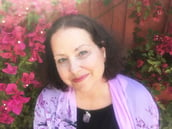Evans Lansing Smith, Ph.D., is core faculty in the Mythological Studies program at Pacifica. He will be presenting “Leonora Carrington: Alchemy, the Underworld, and the Goddess” during Journey Week 2024. Journey Week is an immersive week of learning and connecting at Pacifica Graduate Institute, September 27th – 29th, 2024. For more information and to register, visit us here. I’m delighted to learn more about Leonora Carrington and Evans’ plans for his Journey Week talk about her.
Angela Borda: Born in 1917, Leonora Carrington has been called a “Rebel Visionary” and was a surrealist painter and writer, as well as a founder of the women’s liberation movement in Mexico in the 1970s. Her work and life are comparable to Frida Kahlo, yet I didn’t know much about her until now. What attracted you to her as a figure of study and what is her significance in the fabric of depth psychology?
Evans Lansing Smith: I started first teaching Leonora Carrington when I was working in Texas and I had an M.A. thesis group focused on the Grail Romances in Arthurian Literature. I like to update those classes a little by bringing in, among other aspects, post modernism. Leonora Carrington’s novel The Hearing Trumpet is a fascinating story about a woman put in an elderly institution by her children, and the story goes from there. It involves all the members of the elderly hospital and an international conspiracy to return the grail to the original source, the great goddess. I’ve been teaching The Hearing Trumpet for many years, but recently I’ve done more reading of her fiction, in connection with surrealism. Her memoir Down Below is about fleeing the Nazis after Max Ernst was arrested by them, and Leonora ended up in a mental hospital. The book is not so much related to the grail, but has a lot of hermetic alchemical symbolism.
Angela: I’m now wondering what is the utility and place of surrealism within depth psychology? Images are such a big part of how we work with the psyche in depth psychology, but in the context of scholarship at Pacifica, I’m more likely to see images of a Greek deity or a fairy tale than a melting clock or any of the other iconic images of surrealism. How does the surreal serve the work of the psyche?
Evans: A book should be written about this, the intersection of surrealist practices, active imagination, and painting, which in Leonora’s case was to evoke the energies of the unconscious in the manifestation of the dreamlike in a state of creative reverie. Images from the unconscious can be used as the basis for various paintings. You have a wide array of mythological images that surface in the unconscious, which Jung called the collective unconscious, a hermetic synchronism from different t mythologies that all make their way into the work of people like Leonora.
In the 1940s, when there was an explosion of interest in surrealism painting, people were reading more of Jung and many of them were the great postmodern American painters who we wouldn’t immediately associate with Jung, such as Adolf Gottlieb, Jackson Pollock, and of course, Leonora. There’s a whole other chapter there with Jung and Mexican surrealism emerging during the turbulent time of WWII.
Angela: The subtitle of your talk is “Alchemy, the Underworld, and the Goddess,” and right away, I was hooked. Not to give away everything, but can you give us an idea of how these three concepts relate to Leonora Carrington?
Evans: They come out of a focus on her novel The Hearing Trumpet and the paintings associated with it. She was involved in alchemical studies and of particular importance to her was Jung. The other surrealists were also engaged in the hermetic aspect of the alchemical tradition. In Down Below and The Hearing Trumpet, there is the myth of descent to the underworld, the process of disintegration, death, and rebirth, which is essential to the alchemical processes of putrefaction, nigredo, all of the great alchemical images and ideas, leading to the creation of a new substance. The goddess presides over this alchemical niche of death and rebirth. Of particular importance to Leonora was the triple-goddess initiation she experienced in the novel, when an earthquake strikes Mexico City, identified as the womb and the tomb of Mother Earth. A range of goddess mythologies are fundamental in the mythologies of the underworld, and also central to Jung’s concept of individuation. The goddess presides over that process in Leonora’s fiction and art.
Angela: One of the particulars of your scholarship is that you traveled with Joseph Campbell on study tours in France Egypt, and Kenya. For this year’s Journey Week, we have a Joseph Campbell Foundation Mythic Writing Workshop featured, as well as MYTHFEST. How would you describe Campbell’s legacy within the field of depth psychology?
Evans: Depth psychology is a subcategory of mythological studies and a very important approach to the mythologies that emerge in art and dream and psychological symptoms. Campbell was always appreciative of Jung’s work and would on many occasions give wonderful lectures devoted entirely to Jung that were quite helpful for teaching people who didn’t know much about Jung. He was equally an admirer of Freud. So his preference was to understand the mythological images with the help of the depth psychologies of Jung and Freud but without a dogmatic application of those paradigms for the study of myth. There are many different approaches to the study of myth, and depth psychology happens to be one of them. Campbell went to visit Jung in the 50s, so it’s part of the conversation about Campbell’s legacy, but he drew from a wide range of disciplines, so it’s a large legacy that goes in many different directions, so many multicultural mythologies form all over the world. Just from an anthropological point of view, he made an enormous contribution to the importance of the mythological from a global perspective. A wonderful legacy.
Angela: You already have published ten books, so it’s not that you must publish more! But do you have any upcoming projects to share with us?
Evans: I’ve been putting together a book that focuses on a revisionary approach to the hero’s journey, where the central figures are female, to sharpen the focus on works written by women that engage in the hero journey cycle. Christa Wolf, A.S. Byatt, Angela Carter, Leonora Carrington, and other postmodernist women in the arts. I want to bring the female version of the hero journey cycle and the mythologies associated with it.
Angela: Thank you so much for speaking with me today and I can’t wait to hear more about Leonora Carrington during Journey Week!
Journey Week is an immersive week of learning and connecting at Pacifica Graduate Institute, September 27th – 29th, 2024. For more information and to register, visit us here.

Evans Lansing Smith, Ph.D., has degrees from Williams College, Antioch International, and The Claremont Graduate School. He is the author of ten books and numerous articles on comparative literature and mythology, and has taught at colleges in Switzerland, Maryland, Texas, and California, and at the C.G. Jung Institute in Küsnacht. In the late 1970s, he traveled with Joseph Campbell on study tours of Northern France, Egypt, and Kenya, with a focus on the Arthurian Romances of the Middle Ages and the Mythologies of the Ancient World. His books include:
Romance of the Grail: The Magic and Mystery of Arthurian Myth (ed., Collected Works of Joseph Campbell)
Correspondence: 1927-1987 (ed.): the letters of Joseph Campbell
The Flight of the Wild Gander, (study guide for the Joseph Campbell Foundation)
The Descent to the Underworld in Literature, Painting, and Film: 1850-1950: The Modernist Nekyia
Figuring Poesis: A Mythical Geometry of Postmodernism
Haiku for Aphrodite
The Hero Journey in Literature
The Myth of the Descent to the Underworld in Postmodern Literature
Postmodern Magus: Myth and Poetics in the Works of James Merrill
Ricorso and Revelation: An Archetypal Poetics of Modernism
Sacred Mysteries: Myths About Couples in Quest
Thomas Pynchon and the Postmodern Mythology of the Underworld
Tikkun: Collected Essays
His areas of emphasis include: Myth in Literature from Antiquity to Postmodernism; Arthurian Romances; the Hermetic Tradition; and the Mythologies of Native America. He currently teaches: Mythologies of the Otherworld; Alchemy and Hermeticism; The Epic Imagination, Arthurian Romances, and the Grail; Folklore and Fairytales.

Angela Borda is a writer for Pacifica Graduate Institute, as well as the editor of the Santa Barbara Literary Journal. Her work has been published in Food & Home, Peregrine, Hurricanes & Swan Songs, Delirium Corridor, Still Arts Quarterly, Danse Macabre, and is forthcoming in The Tertiary Lodger and Running Wild Anthology of Stories, Vol. 5.


